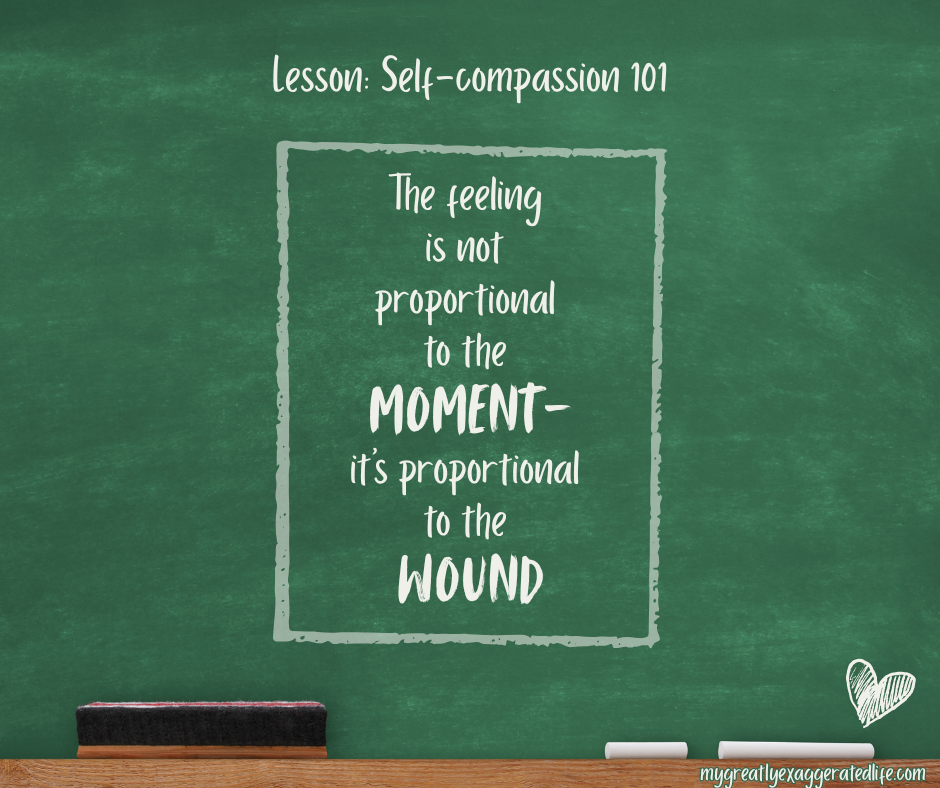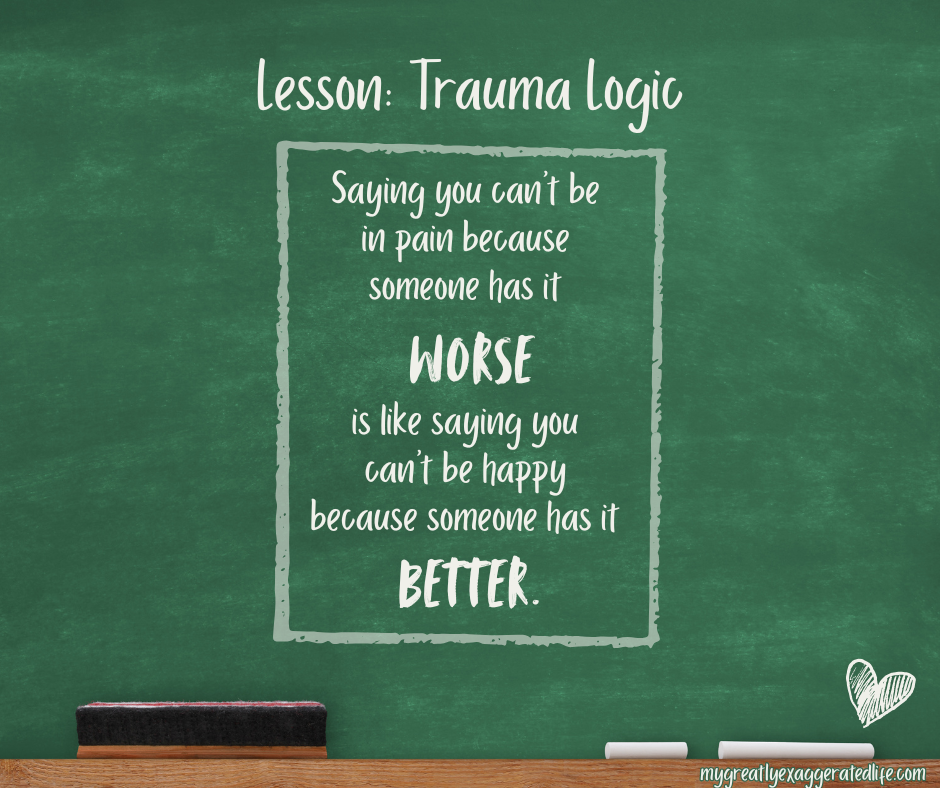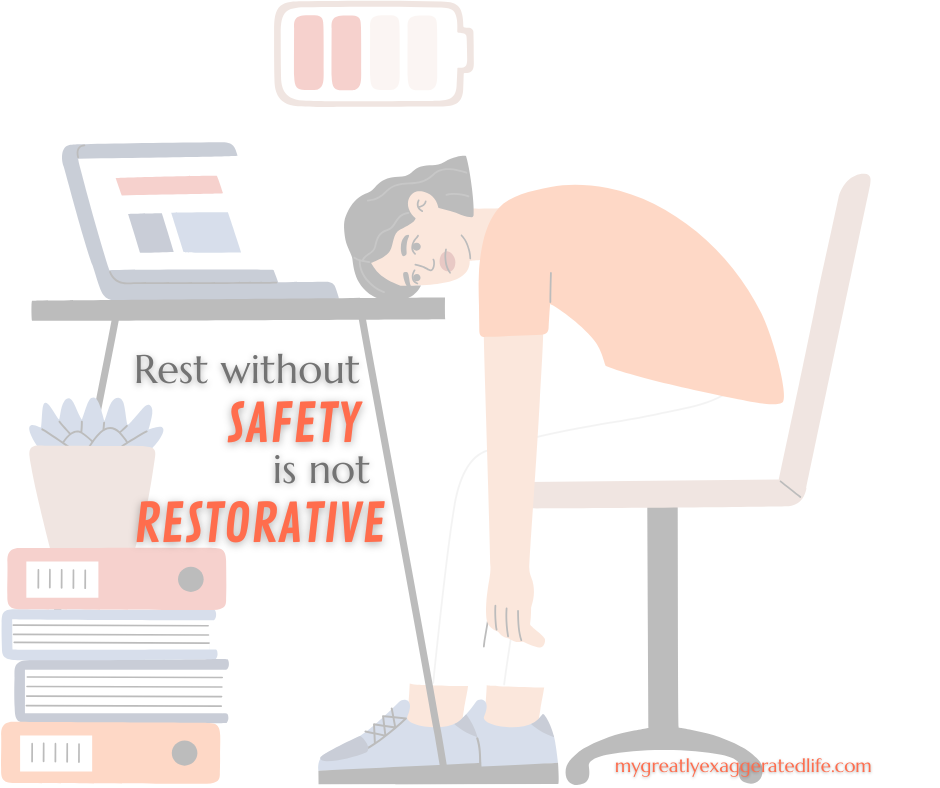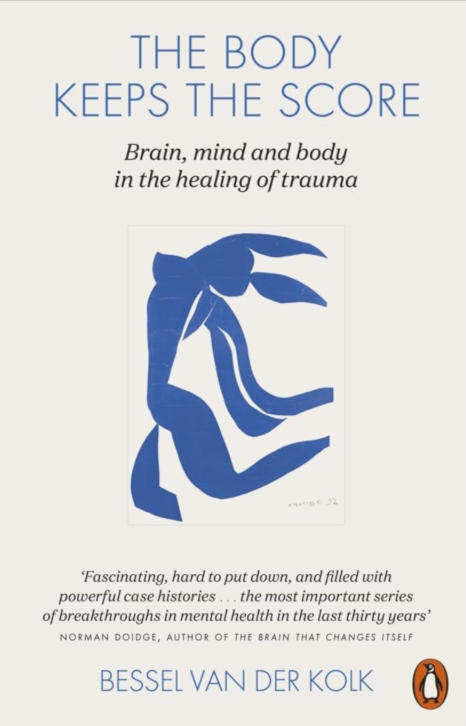Resources & Resonance
Words matter. Especially when you’ve spent a lifetime trying to name what no one else could explain.
This is where I gather the metaphors, reframes, and language that helped me make sense of my story.
It’s my personal lexicon—part glossary, part emotional map—built not to define you, but to offer you words when yours feel too far away.
Clinical Terms In My Language
-
Attention-Deficit/Hyperactivity Disorder isn’t really about not paying attention—it’s about having a nervous system that regulates interest, not importance. That means things that feel urgent, novel, or emotionally charged grab your focus fast, but “boring” or routine tasks (even important ones) can feel impossible. It’s not a lack of discipline. It’s a mismatch between how your brain works and how the world expects you to function.
ADHD can look like forgetfulness, messiness, or procrastination—but it can also be intense creativity, lightning-fast thinking, and big-picture vision. Most of us learned to mask it so well we didn’t even know we had it. For a lot of people it doesn’t get diagnosed until adulthood, after a lifetime of thinking they were just lazy, chaotic, or “too much.”
Turns out, we were never broken. We were just using a map that wasn’t made for our kind of brain.
-
BITE Model (Behavior, Information, Thought, and Emotional Control):
Developed by Steven Hassan, the BITE Model outlines how authoritarian groups (including cults, high-control religions, and manipulative relationships) control individuals. It breaks manipulation down into four categories:Behavior Control: Regulating a person’s physical reality—who they talk to, what they wear, how they spend their time.
Information Control: Distorting or withholding information to limit independent thought, including controlling access to outside sources.
Thought Control: Encouraging black-and-white thinking, using loaded language, discouraging critical thinking or doubts.
Emotional Control: Manipulating feelings of guilt, fear, and shame to keep people obedient and afraid to leave.
This framework is often used in trauma recovery to help survivors understand how their autonomy was systematically broken down—and how to reclaim it.
-
Complex Post-Traumatic Stress Disorder isn’t just about what happened to you—it’s about what kept happening. It’s the slow, grinding erosion of safety over time. Not one event, but a thousand little ones that trained your body to stay on high alert. It's what happens when you grow up in chaos, neglect, emotional abuse, or situations where you had to abandon yourself to stay connected to others.
CPTSD can look like mood swings, people-pleasing, perfectionism, disconnection from your body, or feeling like you don’t know who you are. It’s the fog. The freeze. The inner critic that never shuts up. It’s the panic when nothing’s actually wrong. And the guilt for not being “over it” yet.
But here's the truth: it’s not just in your head—it’s in your nervous system. And you’re not broken. You adapted.
Healing from CPTSD means learning to feel safe in your own body again. Slowly. Gently. In layers. It’s not linear. But it is possible.
-
Not always cloaks and Kool-Aid. Sometimes they look like your childhood church, your family, or the place everyone said would keep you safe. A cult isn’t just about beliefs—it’s about control. It’s when a system, group, or figure convinces you to trade your critical thinking, boundaries, or identity in exchange for belonging, salvation, or fear-based obedience. If questioning makes you feel unsafe, disloyal, or wicked… that’s not faith. That’s indoctrination. And calling it what it is might be the first breath of freedom.
-
Disorganized attachment (also known as fearful-avoidant) is what happens when the very person you instinctively turn to for comfort is also the source of fear or inconsistency. It creates an impossible dilemma: “Come here, go away.” It’s rooted in early relationships that were chaotic, frightening, or emotionally unpredictable—often involving abuse, neglect, or enmeshment.
Instead of developing a stable internal map for connection, people with disorganized attachment grow up with conflicting survival strategies. You may long for closeness but panic when it arrives. You might crave being seen but fear being truly known. Relationships can feel like a trap—something you need but can’t trust.
It often shows up in adulthood as:
Intense push-pull dynamics
Feeling like "too much" and "not enough" at the same time
Overanalyzing texts, tone, silence
Freezing when it’s time to ask for help
Deep shame or self-blame after vulnerability
At its core, disorganized attachment is not a flaw in your character—it’s a nervous system trying to survive two opposing truths at once. Healing doesn’t come from choosing one side of the equation, but from learning how to hold both—and offering yourself the safety you never had.
**Note: you can have this style without abuse or neglect if you and your primary caregiver have a consistent emotional mismatch
-
A state where emotions come on too strong, last too long, or feel impossible to manage. It’s not about being too emotional—it’s about a nervous system that struggles to return to baseline after being triggered.
In MGEL terms, it’s the difference between feeling upset and being hijacked by your own body. Emotional dysregulation can show up as anger outbursts, panic, shutdown, spiraling shame, or what feels like “overreacting” (even though it’s usually a reaction to something much deeper or older).
Often linked to trauma, ADHD, autism, and attachment wounds, it’s not a character flaw—it’s a nervous system stuck in survival mode, trying its best with the blueprint it was given.
-
Executive dysfunction isn’t about being lazy. It’s about the part of your brain that’s supposed to plan, prioritize, start, and finish tasks being... offline. You want to do the thing. You know you should do the thing. But the bridge between intention and action feels like it’s missing planks.
It can look like procrastination, disorganization, forgetfulness—but it feels like staring at a mountain in flip-flops. People say “just start,” and you would love to. But your brain says “nope” and hits the brakes, even on things you want to do. And then you beat yourself up, thinking it’s a willpower problem. It’s not.
Executive dysfunction is the invisible wall you run into over and over. Recognizing it is the first step toward climbing it—with compassion instead of shame.
-
Gaslighting is when someone tries to convince you that your reality isn’t real—on purpose. It’s not just lying. It’s the slow, intentional unraveling of your trust in your own mind. Over time, it can make you question everything: your memory, your instincts, even your sanity.
It sounds like:
“You’re too sensitive.”
“That never happened.”
“You’re overreacting.”
“Stop being so dramatic.”
“You always twist things.”
“Don’t you know I love you?”Gaslighting isn’t always loud. Sometimes it’s a calm tone with cruel words. Sometimes it’s love laced with manipulation. Sometimes it’s silence after a wound. The result is the same: you stop trusting yourself.
The damage runs deep because it doesn’t just hurt—it rewires. It teaches you not to believe your gut. It makes you small. Confused. Dependent. And worst of all, it makes you gaslight yourself.
But that fog? It lifts. Slowly, steadily, with support and truth and time. And when it does—you begin to trust the quiet voice inside you again. The one that always knew.
-
When your nervous system is stuck in “danger mode,” even when nothing’s wrong. It feels like living at DEFCON 5 — scanning the room, braced for impact, never fully at rest. A door slams, someone’s mood shifts, a memory flickers — and your body reacts before your brain even catches up.
Hypervigilance isn’t just awareness. It’s anticipation. It’s your radar blaring at shadows, refusing to shut off.
For me, it feels like sleeping with one eye open. On the outside I look calm, but inside, my muscles are clenched and my body is waiting for the other shoe to drop. Rest isn’t rest when safety never arrives.
-
Late diagnosis is when you finally get the name for what you’ve been living with your whole life—usually ADHD, autism, or both—but it doesn’t come until adulthood. By then, you’ve already built your identity around struggle, shame, or survival. You didn’t know why things were so hard, just that they were, and that people seemed to think it was your fault.
It’s a strange kind of relief. On one hand, things finally make sense. You can trace every “failure,” every meltdown, every coping strategy back to something real. Tangible. Nameable. On the other hand, it hurts like hell. Because now you know it wasn’t laziness. Or selfishness. Or being too sensitive. It was wiring. Biology. Something you never asked for but spent years struggling with anyway.
There’s grief in it. Grief for the younger you who wasn’t supported. Who was mislabeled. Who worked ten times harder just to keep up. But there’s also freedom. Because once you know the truth, you can stop pretending. You can start healing. You can build a life that fits you.
It’s not too late. It never was.
-
Neurodivergent means your brain works differently from what society labels as “normal.” It covers a range of conditions like ADHD, autism, dyslexia, and more—but at its core, it’s not a diagnosis. It’s a description.
Being neurodivergent doesn’t mean broken. It means wired in a way that sees patterns others miss, feels things more deeply, processes information on a different frequency. It means navigating a world that often wasn’t built with you in mind—and figuring out how to survive, adapt, and eventually thrive anyway.
The term itself is a reclaiming. A way to name the experience of always feeling a little “off” or “other,” and realizing you’re not alone. You're not defective—you’re different. And difference is not a deficit.
-
Neurotypical refers to people whose brains work in the way society expects—more or less in line with the standard. They tend to process information, emotions, and social cues in ways that are considered "normal" by mainstream standards. They’re the baseline most systems are built around: schools, jobs, relationships, expectations.
It doesn’t mean life is easy for them. But it does mean they’re usually understood. Their struggles get support. Their habits aren’t pathologized. And when they speak up, people tend to listen.
Neurotypical is what most people assume you are—until you aren’t. And for neurodivergent people, that assumption can be exhausting. Because the rules weren’t written for us, but we’re still expected to follow them.
It’s not a bad word. It’s just not our word.
-
RSD is like a smoke alarm in your nervous system that goes off at the possibility of rejection. It’s the panic you feel when someone seems upset with you. The spiral that starts when a text goes unanswered. The gut-punch of believing you’ve let someone down—even if nothing’s actually happened.
It’s not just being sensitive. It’s an emotional allergic reaction to real or perceived criticism, fueled by a lifetime of feeling “too much” or “not enough.” With RSD, feedback feels like failure. Disapproval feels like abandonment. And even minor conflicts can feel soul-shattering.
This isn’t weakness. It’s a nervous system shaped by fear and wired for protection. Learning to recognize RSD doesn’t make it hurt less—but it helps you separate what’s real from what’s reflex.
-
A set of lasting psychological, emotional, and sometimes physical effects that arise from prolonged exposure to authoritarian, fear-based, or spiritually abusive religious systems. RTS often includes symptoms of complex PTSD, such as guilt, shame, dissociation, identity confusion, hypervigilance, and difficulty trusting oneself. Unlike a single traumatic event, RTS is the slow-burn impact of indoctrination, exclusion, and spiritual manipulation—especially when tied to childhood development or family structures. It’s not about losing faith; it’s about surviving systems that taught you fear was holiness and obedience was love.
Unofficial Terms That Explain My Experience
-
The freeze that happens when you know something is coming—an appointment, a meeting, a scheduled task—and it paralyzes your ability to do anything useful before it arrives.
You technically have time.
But your body says, “Don’t start. You’ll just have to stop.”In MGEL, this refers to the nervous system's shutdown response to looming events—especially when past experiences have taught you that time is unreliable, interruptions are unsafe, or effort gets wasted.
It’s not laziness.
It’s emotional limbo dressed up as logic. -
These are the reactions I can’t fake—or suppress.
Tense shoulders. Shallow breath. The full-body flinch when something harmless hits a nerve.It’s the proof that lives in my nervous system, not my memory.
The kind of evidence that bypasses language and goes straight to sensation.
Even when my mind doubts, my body remembers.This is how I know it was real.
Not because I want it to be.
But because my body never had the option of pretending otherwise. -
Subconscious survival patterns stored in the body—especially in the amygdala—that dictate how you respond to stress, shame, danger, or emotional triggers.
In MGEL, these are the pre-programmed scripts your system runs when something feels familiar in the wrong way. They're not conscious choices—they’re emotional muscle memory from earlier trauma, learned helplessness, or chronic invalidation.
Often outdated, often invisible—but deeply powerful until rewritten.
They’re not who you are. They’re what kept you alive. -
Hyperfocus is the other side of the ADHD coin. It’s when your brain locks onto something so intensely that the rest of the world fades out. Hours pass like minutes. Hunger, noise, people—none of it registers. You’re in it.
It can be magical—like finding your superpower. You get more done in one burst than most people do in a day. But it can also derail your whole schedule, especially when you fall into a rabbit hole that isn’t time-sensitive or urgent (but feels vital).
Hyperfocus isn’t control. It’s a current that pulls you under. The trick is learning how to catch the wave and how to get back to shore. Because when it’s managed well, hyperfocus isn’t a flaw—it’s fuel.
-
A toxic, internalized belief that you are not just wrong—you are bad. Unlike healthy shame, which signals social missteps or moral misalignment, malignant shame becomes an identity. It’s not “I made a mistake,” it’s “I am the mistake.”
This kind of shame is often born from chronic invalidation, abuse, emotional neglect, or being blamed for things that weren’t your fault. Over time, it infects how you see yourself, how you think others see you, and what you believe you deserve.
In MGEL terms, malignant shame is the silent narrator behind self-erasure, people-pleasing, and never feeling “good enough to exist.” It’s sticky, insidious, and usually invisible—because it teaches you to hide it even from yourself.
But it can be named. And once named, it can be replaced.
-
Masking is what happens when being yourself doesn’t feel safe. It’s the performance you learn to put on to blend in, to avoid judgment, to survive. For neurodivergent people, especially those with ADHD or autism, masking can look like smiling when you're overwhelmed, forcing eye contact, rehearsing conversations in your head, or copying how others act so you don’t stand out.
It’s knowing you’re different, and trying to camouflage the parts that might get you excluded. Not because you’re fake—but because the world taught you you’d only be loved if you were easier to handle.
Masking isn’t just exhausting. It’s disorienting. It chips away at your sense of self because after a while, you can’t tell what’s the mask and what’s you anymore. You start to wonder if anyone actually knows the real you. Or if you even do.
Unmasking is a slow, brave process. It’s not about being raw all the time—it’s about choosing when, where, and with whom to be fully yourself. And learning that you were never too much. You were too masked.
-
The intense nervous system freeze that happens right before doing something that draws attention to yourself—especially something that feels vulnerable, exposing, or new.
In MGEL, it describes the moment your mind knows you're safe, but your body still remembers the last time you weren’t.
The fear of falling again—metaphorically or emotionally—causes a full-system hesitation, often misinterpreted as weakness or procrastination.But it’s not failure.
It’s just your body saying, “Are you sure? Last time we crossed this bridge, we almost drowned.”The moat feeling doesn’t mean you’re broken.
It means your survival system is active—and you’re doing something that matters. -
The earliest emotional injury that shaped your internal world—often from childhood—where identity, safety, or connection was first compromised.
It marks the beginning of a split between who you truly were and who you had to become to survive.
These moments aren’t just painful memories; they’re blueprints that influenced your nervous system, beliefs, and behaviors long after the event passed.
Recognizing the Original Wound can be the first step in reclaiming your voice, your truth, and your wholeness. -
The opposite of self-gaslighting. A deliberate, sometimes defiant act of turning toward yourself with tenderness, even when your brain insists you don’t deserve it. It means believing your pain matters without having to prove it. It’s refusing to abandon yourself in the aftermath of abandonment. Not a loophole or excuse—but a doorway back to humanity when shame tries to shut you out.
-
That moment when one thought drags another down with it, and suddenly you’re not just replaying what happened — you’re stacking every failure you’ve ever had on top of it. Shame spirals are sticky; they feed on themselves. One tiny trigger (“I said the wrong thing”) turns into “I always say the wrong thing,” which turns into “I’m broken,” which lands in the pit: “I’ll always be this way.”
The cruel part is how convincing it feels while you’re in it. A shame spiral doesn’t just replay the past — it rewrites your whole identity.
-
A sudden wave of shame or self-invalidation triggered by expressing hurt, vulnerability, or truth—usually accompanied by the internalized voice of an authority figure dismissing your pain.
For me, it refers to the mental backlash that tells you you're overreacting, faking it, or “stealing valor” from real victims. It’s not about being too sensitive—it’s about being told you’re not allowed to be.
-
The kind of empathy that hurts you instead of helping anyone else. It’s when your ability to feel someone else’s pain becomes so intense that you absorb it, drown in it, or forget where you end and they begin.
Unlike healthy empathy—which creates connection and understanding—toxic empathy leads to burnout, resentment, emotional enmeshment, or losing your sense of self. It’s common in people with trauma histories, fawn responses, or hyper-attuned nervous systems that were trained to scan others for safety cues.
In MGEL terms, it’s “bleeding out in someone else’s storm” because your inner system is wired to prioritize their pain over your own reality. It can feel noble—but it’s often just self-erasure wearing a kindness costume.
-
Someone who has survived trauma but feels they don’t deserve validation, care, or recognition—often because their suffering was minimized, disbelieved, or self-silenced. A result of gaslighting, cultural shame, religious indoctrination, or comparison with others who “had it worse.”
Visuals
When I hit on an idea, sometimes it helps to see it visually. Here’s where my “aha!” moments live.
Resources
This is where I’m gathering the voices, tools, and ideas that are helping me find my way through the fog. Books, videos, articles—anything that made something click.
I’m not a therapist or expert, just someone trying to understand.
These are the sources that helped me feel less alone, gave me language for what I was living,
and offered light when I couldn’t find my own.
Take what resonates. Leave what doesn’t. Come back if and when you’re ready.







